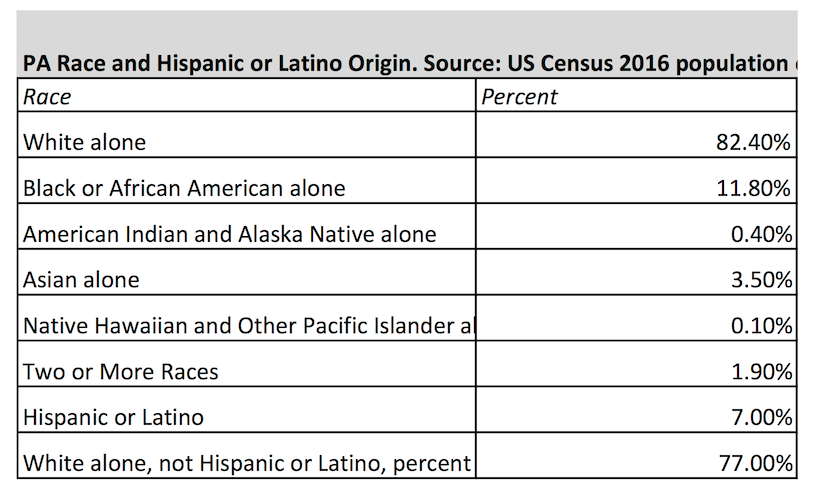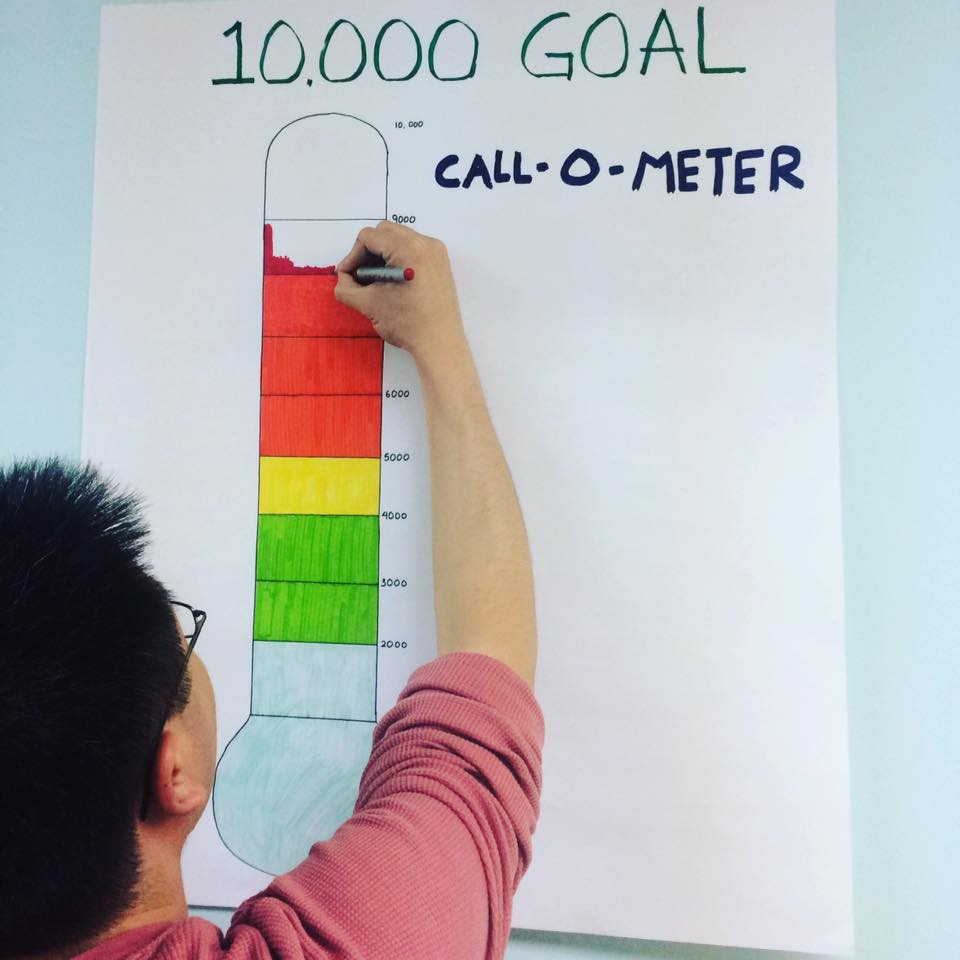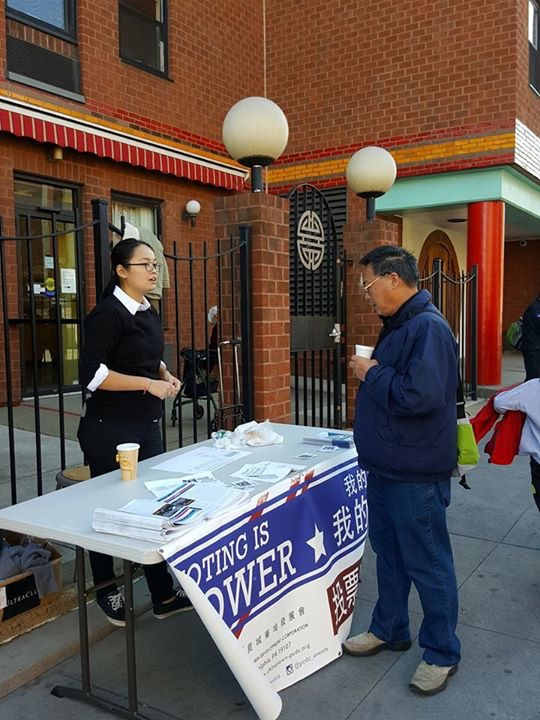African-American, Asian American/Pacific Islander (AAPI), and Latinx communities are the fastest growing segments of Pennsylvania’s population, according to U.S. Census data.
Yet, you would never know it by looking at the members of Pennsylvania’s General Assembly.

The 253-member state legislature is 94 percent White and 82 percent Male. That means there are only 45 women in the state House and Senate combined, 25 people of color, and one Asian American member. If the legislature proportionately reflected the state’s racial demographics, Pennsylvania’s General Assembly would have a lot more members of color and women -- membership would be comprised of at least 28 African Americans, nine Asian Americans/Pacific Islanders, 17 Latinx, and 127 women. With this lack of representation, it goes without saying that the voices of immigrants -- at least, recent immigrants to the U.S. -- are rarely listened to in Harrisburg.

SEAMAAC sets goals for its volunteers.
Photo Credit: Andy Toy
Five AAPI-serving organizations (Asian Americans United, Pennsylvania Immigration and Citizenship Coalition, Philadelphia Chinatown Development Corporation, SEAMAAC, and VietLEAD) are running a pilot project, which if taken to scale, could change this. There are just over 50,000 eligible AAPI voters in Philadelphia (not all of whom are immigrants). Yet only half are registered. Compare this to the more than 90 percent registration rate among Black and White Philadelphians. Traditional efforts at increasing voter turnout -- outreach from political parties, candidates, or even multi-issue organizations -- rarely develop messages or strategies specific to AAPI communities. Government efforts, state, or county-level election administrators, are not required by law to provide voter registration or election information in languages spoken by limited English proficient (LEP) communities, and thus provide few resources to increase participation rates among these communities.
The key gap in any effort to increase AAPI civic engagement is trusted, authentic messengers to regularly and routinely encourage participation. “Philadelphia’s growing Asian and Latino immigrant populations are halting the city’s population decline, repopulating neighborhoods, and revitalizing commercial corridors,” says Alix Webb, executive director of Asian Americans United. “We know that these new and vulnerable immigrant communities must be engaged in civic life to ensure that their needs are met and that their voices are heard. We need leaders from our communities -- who know our communities -- to be making the decisions that affect our lives. So, we decided to double down on working to close the voter registration gap even before 2016. AAU sees this as a necessary continuation of its organizing and community building work of the last 30 years to ensure that people of Asian ancestry exercise leadership to build their communities and unite to challenge oppression.”
The lack of AAPI representation among elected leaders is one reason that AAPI communities register and vote much less than other voters. Other factors include cultural and political differences, language barriers, lack of understanding of the process, and concerns about whether voting even makes a difference. The people who are best positioned to run programs and execute innovative ideas that address these reasons -- not surprisingly -- are groups that serve AAPI communities year-round, and are AAPI-led. “Over the last three years, AAU has significantly expanded its programming designed to empower Asian immigrant youth and community members to become civically engaged and shape the future of their communities. More than one hundred youth leaders have been trained to register voters and get out the vote resulting in thousands of phone banking calls to non-English speaking citizens, articles published in local ethnic-language-based media, language specific voter education events, and hundreds of completed voter registrations,” says Webb.
The five AAPI-serving organizations have come together to put AAPI communities on the political map in towns, cities, and statewide races where the voice of AAPI community members is often ignored. Together, the groups have set collective goals for voter registration and election participation increases over the next four years and defined what each individual member of the collective will do to achieve them. The AAPI civic engagement effort is initially focused on five counties:

Each of the organizations involved has a different approach to reducing the voter registration gap and increasing voter participation.
Philadelphia Chinatown Development Corporation for instance registered hundreds of voters in 2016 by simply integrating a conversation about the importance of voter registration into existing services offered to clients. Asian Americans United empowered youth leaders to set up tables in public places to collect voter registrations from AAPI community members. Pennsylvania Immigration and Citizenship Coalition focused on registering voters at new citizen ceremonies.

Pennsylvania Chinatown Development Corporation works the polls on Election Day.
Photo Credit: John Chin
Beyond voter registration, all of the groups reached out directly to voters encouraging them to participate in the 2016 election. VietLEAD used the sophisticated data tools offered by Pennsylvania Voice to find Vietnamese voters and then talk to them about voting on the phone and sometimes at a prospective voter’s front door. These interactions were especially impactful when offered in both English and Vietnamese.
SEAMAAC employed a place-based strategy and knocked on hundreds of voters’ doors -- both AAPI and other races -- to have in-person conversations about the importance of voting. When possible, they also offered multi-lingual services.
Generating tens of thousands more votes from AAPI communities may not seem significant in a state with nine million registered voters. Take it county-by-county though and it doesn’t take a lot of extra voters, especially in a local race, to make a difference. 25,000 extra votes would have a major impact on a citywide race in Philadelphia, 10,000 extra votes could change the outcome of a district council race in Allegheny, and 3,000 extra voters in a Delaware County Mayor’s race could change the outcome. The AAPI civic engagement effort is not just focused on talking about voting with clients, youth leaders, and community members. Instead, through conversations about issues and legislation that affect AAPI communities, basic civics lessons, and a lot of listening to the needs of community members, these five organizations are creating a different way of engaging potential voters than the typical blitz of mail and robocalls that have become the norm at election time.
This work has largely been made possible by a nationally-focused grantmaker that promotes civic engagement, health, and well-being among the AAPI community. This foundation has made a five-year commitment to engaging the AAPI community in multiple states. Their investment in AAPI civic engagement is unique in that it is helping to build the basic infrastructure required for civic engagement programs in the AAPI community. The question is whether other national foundations, and even more importantly, Pennsylvania and regional funders, will chip in to support the effort too.
Another critical element of the AAPI civic engagement program has been the role of the entire Pennsylvania Voice partnership, this includes a statewide network of nearly 40 organizations. Partners share a vision of full participation and representation in our democracy of the New American Majority, historically underrepresented and marginalized communities, including young people (under the age of 34), single women, and people of color in Pennsylvania. “The vision and commitment that each partner organization brings to the table, along with the support of partnership staff and board leaders, has allowed Pennsylvania Voice to become the place where the state’s top progressive leaders work together on long-term strategies,” says Erin Casey, Pennsylvania Voice’s executive director. “The growth of immigrant communities, and the growth of people of color communities all over the state is the future of public policy in Pennsylvania.”
To be a part of the Pennsylvania Voice partnership, an organization makes a commitment to meet measurable goals, set collectively annually, that help build the power needed to break down barriers to civic participation, restore confidence in government, and bring historically marginalized populations and their issues to the forefront of public discourse. Pennsylvania Voice staff supports the AAPI civic engagement effort by making sure that plans and goals are aligned to achieve collective impact to the greatest extent possible. In addition, staff provide technical assistance, data and technology tools, and analysis about specific trends among AAPI voters in the state. Collective impact work around civic engagement cannot be successful without trust among participating organizations, a willingness to write and work from a shared plan, and an understanding of best practices in the field. This kind of collective impact model is something that all members of the Pennsylvania Voice partnership can help replicate and scale in other communities throughout the state.
Pennsylvania Immigration and Citizenship Coalition’s participation in this collective effort is an expansion of long-standing civic engagement programming. “From the legislative and legal attacks on sanctuary cities, to physical attacks on people of color and those perceived to be Muslim, to the gutting of public education and the lack of any real plan to create jobs in Washington and Harrisburg, it is clear that immigrant communities will be ignored or worse scapegoated if we don’t build political power," says Sundrop Carter, executive director of the Pennsylvania Immigration and Citizenship Coalition. Heightened political rhetoric attacking immigrant communities is going to have deleterious effects on the growth and vibrancy of cities like Philadelphia, especially the threat of elected officials federally, and at the state level, even potentially revoking funding from the city because of its “sanctuary city” policy. Philadelphia’s “sanctuary city” policy limits communication between local law enforcement and federal immigration authorities. The goal is to make sure that people who report, witness, or commit crimes are treated like any other resident of the city. In cities without a sanctuary policy, immigrant communities are less likely to extend trust to officers of the law, and sometimes by extension anyone in government. “We need to -- and plan to -- perfect voter education and political engagement among New Americans," says Carter. "We can’t get around the reality that immigrant and refugee communities are under attack by lawmakers. When anti-immigrant sentiment is codified in law, the best defense we have is the power of the vote.”
Members of the AAPI community care about many issues in addition to “sanctuary city” status. From the debate about the Affordable Care Act to the push at the state level to provide adequate funding for public education to gentrification, there are many ways to engage potential AAPI voters, including those who live in suburbs and cities alike. With the support of an innovative funder, and strong backbone support from Pennsylvania Voice, this coordinated effort is building a model that shows why and how supporting organizations that are already embedded in communities are the most likely to make real change. This model could be taken to scale in other communities of color -- whose share of the population grows in every part of Pennsylvania. In the meantime, the five AAPI-serving organizations are working together to enact a plan that will ultimately make the AAPI community a political force to be reckoned with in Pennsylvania’s future.


